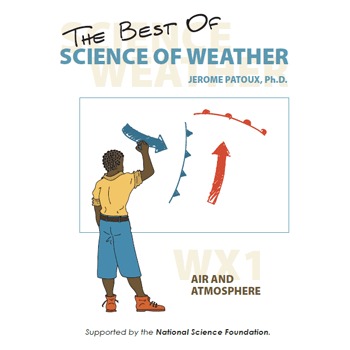Science of Weather - WX1: Air and Atmosphere
Jerome Patoux
138 Followers
Grade Levels
2nd - 12th, Adult Education, Homeschool
Subjects
Resource Type
Formats Included
- PDF
Pages
116 pages
Jerome Patoux
138 Followers
Description
This series is the first of the Science of Weather digital extensions, a digital version of the original Science of Weather curriculum, also available in print. While the original paper version was published as one single volume of worksheets, and separate teaching notes in 5 volumes, these new series contain both the worksheets and the teaching notes, and are broken down by themes, to accommodate teachers who might be interested in teaching a particular topic, rather than a full blown, year-long, weather and climate curriculum. (If, however, you are only interested in the worksheets, consider downloading the student workbook. If you are interested in the entire set of teaching notes, consider downloading the "5-volume set.")
WX1 Air and Atmosphere contains a series of experiments about the properties of air and the composition of the atmosphere. It actually does not contain much weather per se -- if you want to dive straight into weather applications, consider starting with WX2 Heat and Conduction. This first series of activities proves to be useful, however, for students who have a limited background in science in general, and physics in particular, especially when it comes to states of matter and microscopic vs. macroscopic properties of solids, liquids, and gases. It allows us to get started, before we hit more challenging concepts. Here students learn about the following:
- Air takes up space.
- Air has mass.
- Properties of solids, liquids, and gases (macroscopic and microscopic).
- Atoms and molecules (and molecular structure).
- Respiration and photosynthesis.
- Aristotle and Galilei (and their experiments to determine whether air has mass/weight).
- Properties of carbon dioxide (in particular its density).
- The 18th-century history of the breakdown of the composition of air (spoiler alert: someone gets guillotined!)
- The recent increase in CO2 concentration (contrasted with natural seasonal variations).
- The evolution of our atmosphere from the formation of the solar system to this day.
Students also learn to think, explain, and write in logical format, showing cause-and-effect relationships. They apply specific math concepts (graphing, axes, x- and y-increments, slope, y-intercept, line fitting, equation of a line) and practice working with percentages, fractions, ratios, and pie charts.
The first activities can be adapted for grades 2 to 5 by simplifying the discussions and explanations. Otherwise, most of the series will be well suited for grades 6 to 12, apart from the last assignment, which is written in the format of the SAT and is more appropriate in high school. I also use these worksheets as starting points and activities in professional development workshops. This particular series is a good complement/supplement to existing weather, climate, and environmental science modules, such as FOSS Air and Weather, FOSS Properties of Matter, FOSS Weather and Water, STC Weather, and It's About Time EarthComm.
All the activities are aligned with the national standards, as made explicit at the end of each activity in these Teaching Notes.
For more information, visit www.scienceofweather.org
Science of Weather is licensed under a Creative Commons Attribution-NonCommercial-NoDerivs 3.0 Unported License.
WX1 Air and Atmosphere contains a series of experiments about the properties of air and the composition of the atmosphere. It actually does not contain much weather per se -- if you want to dive straight into weather applications, consider starting with WX2 Heat and Conduction. This first series of activities proves to be useful, however, for students who have a limited background in science in general, and physics in particular, especially when it comes to states of matter and microscopic vs. macroscopic properties of solids, liquids, and gases. It allows us to get started, before we hit more challenging concepts. Here students learn about the following:
- Air takes up space.
- Air has mass.
- Properties of solids, liquids, and gases (macroscopic and microscopic).
- Atoms and molecules (and molecular structure).
- Respiration and photosynthesis.
- Aristotle and Galilei (and their experiments to determine whether air has mass/weight).
- Properties of carbon dioxide (in particular its density).
- The 18th-century history of the breakdown of the composition of air (spoiler alert: someone gets guillotined!)
- The recent increase in CO2 concentration (contrasted with natural seasonal variations).
- The evolution of our atmosphere from the formation of the solar system to this day.
Students also learn to think, explain, and write in logical format, showing cause-and-effect relationships. They apply specific math concepts (graphing, axes, x- and y-increments, slope, y-intercept, line fitting, equation of a line) and practice working with percentages, fractions, ratios, and pie charts.
The first activities can be adapted for grades 2 to 5 by simplifying the discussions and explanations. Otherwise, most of the series will be well suited for grades 6 to 12, apart from the last assignment, which is written in the format of the SAT and is more appropriate in high school. I also use these worksheets as starting points and activities in professional development workshops. This particular series is a good complement/supplement to existing weather, climate, and environmental science modules, such as FOSS Air and Weather, FOSS Properties of Matter, FOSS Weather and Water, STC Weather, and It's About Time EarthComm.
All the activities are aligned with the national standards, as made explicit at the end of each activity in these Teaching Notes.
For more information, visit www.scienceofweather.org
Science of Weather is licensed under a Creative Commons Attribution-NonCommercial-NoDerivs 3.0 Unported License.
Total Pages
116 pages
Answer Key
Included
Teaching Duration
N/A
Report this resource to TPT
Reported resources will be reviewed by our team. Report this resource to let us know if this resource violates TPT’s content guidelines.




